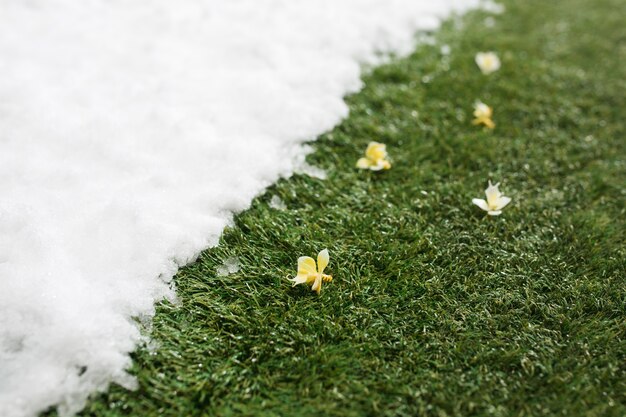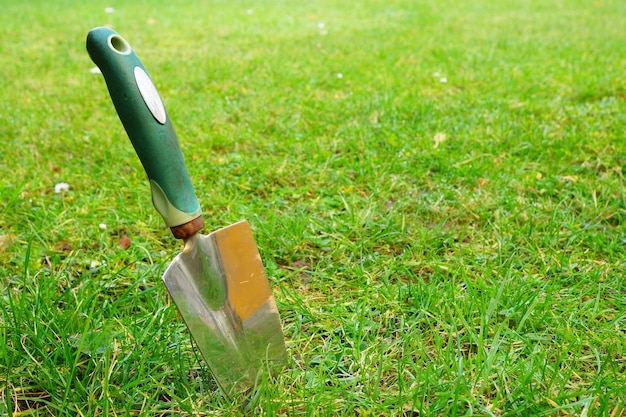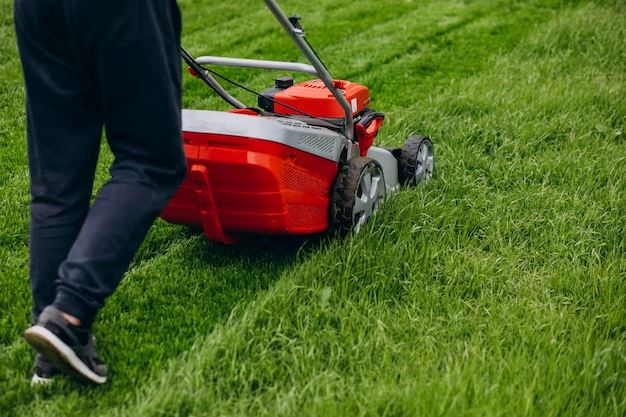After a long winter, you wake up from dormancy and your lawn needs special attention. Spring maintenance is crucial for healthy, lush green in the warmer months.
In this article, we will guide you through the essential steps of lawn care in spring. From the initial assessment of the lawn's condition and the right mowing technique to fertilizing and scarifying - we cover everything you need to know to prepare your lawn optimally for spring.
Follow our comprehensive guide to ensure your lawn shines in all its glory this year.

Spring lawn care check: How is your lawn looking after the winter?
When the snow melts and the first rays of spring sunshine reach the garden, it's time for a thorough assessment of your lawn. The cold season may have left traces that require your attention.
Inspect the turf for signs of damage such as dead patches, moss growth or compaction of the soil. These indicators show that your lawn needs special care to get back into shape.
It is equally important to check the pH value of the soil, a crucial factor for the health of your lawn. An unbalanced pH value can impair the growth and vitality of grasses.
A simple soil analysis can show you if liming or other soil amendments are needed to maintain the ideal pH level for a healthy and resilient lawn.

The turf in spring: the basics of pre-season preparation
Goodbye leaves and debris: the first step in lawn cleaning
Before the new growing season begins, it is crucial to clear your lawn of leaves, broken branches and other remnants of winter. This cleaning work is not only important for aesthetic reasons.
Leaves and debris can block light and inhibit air circulation, which can lead to moisture build-up and disease. A thorough clean ensures your lawn can breathe and is ready for the growing season ahead.
Why and how to aerate the lawn in spring
After the cold season, it is just as important to aerate your lawn. This promotes the penetration of oxygen, water and nutrients to the roots. Lawn aeration can be done by simply pricking with a garden fork or with special aeration tools. This measure combats soil compaction, which is often caused by snow and rain in winter.
By giving your lawn air and space to breathe in spring, you lay the foundations for a healthy, strong lawn in the coming months.

Restoring green vitality: The art of scarifying
Scarifying is a crucial step in revitalizing your lawn after the cold season. The best time for this is spring, when the ground is no longer frozen but also not too wet.
Start by mowing the lawn thoroughly to shorten the blades of grass. Then use a scarifier to scarify the turf and remove moss and thatch. This process promotes aeration of the soil and stimulates the growth of new blades of grass.
When treating bare patches in the lawn, it is advisable to apply lawn seed after scarifying. Choose a lawn seed mixture that suits your location and soil type. With this method, you can effectively fill in bare patches and give your lawn an even, dense appearance.
Soil care: tips for optimizing the pH value and nutrients
A balanced soil pH is essential for the health and growth of your lawn. Soil that is too acidic or too alkaline can impair the grasses' nutrient uptake and lead to a weak, susceptible lawn.
A soil analysis provides information about the current pH value and the nutrients present. If the pH value is not in the ideal range of 6.0 to 7.0, you can adjust it with lime (for acidic soil) or sulphur (for alkaline soil). The right fertilizer also plays a decisive role. Choose a lawn fertilizer that is tailored to the specific needs of your lawn, especially with regard to nitrogen, phosphorus and potassium.
Regular, needs-based fertilization ensures that your lawn receives all the nutrients it needs to stay strong and resilient. Also observe the recommended application rates and times to avoid over-fertilization and protect the environment.
Masterful mowing: strategies for a magnificent lawn in spring
An essential part of spring lawn care is establishing an effective mowing schedule. The first mowing should take place as soon as your lawn begins to actively grow, usually when it has reached a height of around 5 cm. Make sure not to cut more than a third of the grass blade length to effectively minimize stress on the lawn.
A common mistake is to mow the lawn too short, which can lead to weakening and susceptibility to weeds and diseases. For the perfect mowing result, it is also important to use sharp mower blades to ensure clean cuts.
Alternate the mowing direction every time you mow to promote even growth and avoid compaction of the soil. A well-planned mowing schedule will go a long way to keeping your lawn looking healthy and attractive in spring.
Effective watering tactics for a spring-fresh lawn
Adequate watering is a key element of your lawn's spring maintenance. In spring, you should water your lawn so that the soil is soaked to a depth of 10 cm, which is usually around 20-25 liters of water per square meter.
This amount of watering varies depending on the soil type and weather conditions. Watering can be reduced on cooler spring days or in rainy weather.
Check the soil moisture regularly to make sure your lawn is getting enough water without being overwatered. Targeted watering encourages deeper roots and helps the lawn to be better equipped to withstand dry periods in summer.

Fertilizer wisdom: Nutrient boost for your spring lawn
The right fertilizer is an essential building block for the healthy growth of your lawn. In spring, it is particularly important to choose the right fertilizer to revive your lawn after winter dormancy.
Look for a fertilizer that offers a balanced mix of nitrogen, phosphorus and potassium. Nitrogen promotes growth and green color, phosphorus strengthens the roots and potassium improves the overall resilience of the lawn.
As far as the frequency of fertilization is concerned, it is advisable to fertilize the lawn in early spring to stimulate growth. A second fertilization can be applied later in the spring to maintain the nutrient supply.
Make sure to distribute the fertilizer evenly and follow the instructions on the packaging regarding dosage exactly. Over-fertilizing can damage the lawn and is harmful to the environment. These techniques will ensure that your lawn gets all the nutrients it needs for strong and healthy growth in spring.
The perfect lawn care follow-up: tips for after mowing and fertilizing
Aftercare of your lawn after mowing and fertilizing is essential to maintain its health and beauty. After mowing, you should not remove the clippings unless there are too many. This acts as a natural fertilizer and helps to retain moisture.
However, make sure that there are no large piles, as these can smother the grass underneath. After fertilizing, it is important to water the lawn thoroughly. This helps to work the fertilizer into the soil and avoid burning the grass.
Avoid walking on the lawn immediately after fertilizing to ensure even nutrient distribution and avoid contamination. These simple maintenance tips will help maximize the benefits of mowing and fertilizing and keep your lawn looking its best.

Fighting weeds and pests: green strategies for your lawn
Spring not only brings new growth, but also challenges in the form of weeds and pests. Early identification and control of these invaders is crucial for the health of lawns.
Start with a thorough inspection of your lawn to identify weeds and signs of pest infestation. When controlling weeds, it is effective to remove them manually, especially if they are still at an early stage of growth.
For natural pest control, nematodes can be used to target specific pests such as grubs without damaging the lawn.
Another natural method is to encourage beneficial insects that eat pests by creating a diverse environment with native plants. These eco-friendly approaches help to protect your lawn from weeds and pests while preserving the ecosystem.
A fresh start on the lawn: reseeding and overseeding in spring
Reseeding your lawn in spring is a crucial step in eliminating bare patches and promoting a dense, green lawn. If your lawn looks sparse after winter, it's a clear sign that it's time to overseed.

Before you start, loosen the soil slightly and remove weeds and dead grass. Spread the seeds evenly and cover them lightly with soil to ensure contact with the soil and promote germination. Light watering, but without puddling, is necessary immediately after sowing.
Make sure that the soil remains moist in the following weeks. Once the lawn is properly seeded, you will be rewarded with a lush, healthy lawn that will last all summer long.
Summer fit: How to optimally prepare your lawn for the hot season
Preparing your lawn for summer starts in spring. Ongoing maintenance is essential to ensure that your lawn remains healthy and robust during the warmer months.
Important summer maintenance tips include regular mowing, although the grass height should not be reduced too much, as longer blades of grass are more resistant to heat and drought. Watering deeply, but not too frequently, encourages strong root systems.
Avoid common mistakes such as overwatering or fertilizing too often, as this can lead to root damage and fungal infestation. Balanced lawn care in spring lays the foundation for a healthy, dense lawn that stays green and vibrant all summer long.
Lawn care all-round view: Your guide for a whole year
In conclusion, we recommend that you treat the year-round maintenance of your lawn as an ongoing project that, with the right knowledge and dedication, will lead to success. Start in the spring with thorough cleaning, aeration and proper fertilization to lay a solid foundation for your lawn.
In summer, regular mowing and watering as required are essential to maintain its strength and resilience. Not forgetting ongoing weed and pest control and timely reseeding to ensure the density and vitality of the lawn.
To avoid common maintenance mistakes, we recommend that you always pay attention to the specific needs of your lawn. With this careful and thoughtful care throughout the year, you can look forward to a robust and vibrant lawn that will beautify your garden.




